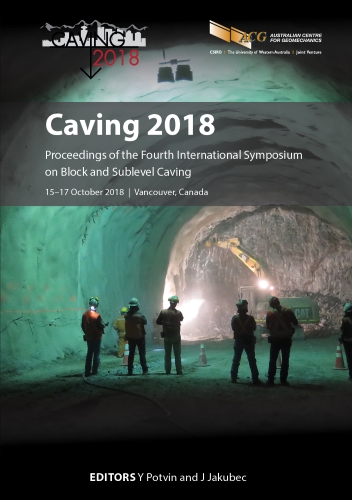A systems approach to mining innovation

|
Authors: Morrison, DM; Drylie, V; Labrecque, PO |
DOI https://doi.org/10.36487/ACG_rep/1815_39_Morrison
Cite As:
Morrison, DM, Drylie, V & Labrecque, PO 2018, 'A systems approach to mining innovation', in Y Potvin & J Jakubec (eds), Caving 2018: Proceedings of the Fourth International Symposium on Block and Sublevel Caving, Australian Centre for Geomechanics, Perth, pp. 511-518, https://doi.org/10.36487/ACG_rep/1815_39_Morrison
Abstract:
Any innovation in part of the mining process has to be integrated into a production system. The mineral dressing system and the tailings management system are easily recognisable as process systems, managed by trained process engineers. The mining process, and especially the underground mining process, have somehow escaped the constraints imposed by the process engineering included in manufacturing operations and is still regarded as a series of almost separate activities – drill-and-blast, ventilation, ground support, ore transfer, and backfilling, each with its own specific expertise and practitioners. This discrete approach has been successful for relatively small-tonnage operations, but it begins to fail as the daily production demand increases. Many underground metal mines using bulk mining and fill have been successful in producing 5,000–8,000 tpd, and the same production equipment platform was adopted for block caving operations in low-grade copper porphyry operations to achieve more than 50,000 tpd. These mines are struggling to meet design targets of 100,000 tpd, at the same time that bulk mining operations are struggling to maintain their production levels with greater ventilation and logistical challenges at depth. The inability to meet current production targets has led to a series of tactical responses, such as layout changes, equipment automation and electrification, and other new technologies. We make the case that the implementation of isolated technologies into deep, hightonnage operations are unlikely to be successful unless they are integrated into a mine production system that is designed to address all the system constraints. We believe that the last technological transition has created a progress trap that will prevent mines achieving higher production rates. We believe a ‘systems approach’ to mining innovation is essential if we are to transition to technology platforms that can meet future performance targets, match demographic projections and enable the industry to meet future metal demand.
Keywords: Theory of Constraints, high-tonnage operations, technology transformation, progress trap
References:
Morrison, DM 1991, ‘Management of technology in hardrock mines’, Proceedings of the CIM 93rd Annual General Meeting, Canadian Institute of Mining, Metallurgy and Petroleum, Westmount.
Morrison, DM 2017, ‘Transforming the metal mining industry’, Proceedings of Mines and Technology 2017, Mines and Money, London.
Siemens, J, Jansen van Rensburg, G & Vender Merve, F 2014, Continuous Loading – a safe, efficient and productive alternative for the loading of muck at the development face’, Proceedings of the 6th International Platinum Conference, The Southern African Institute of Mining and Metallurgy, Johannesburg, pp. 281–290.
Wright, R 2004, A Short History of Progress, House of Anansi Press, Toronto, pp. 29–53.
© Copyright 2025, Australian Centre for Geomechanics (ACG), The University of Western Australia. All rights reserved.
View copyright/legal information
Please direct any queries or error reports to repository-acg@uwa.edu.au
View copyright/legal information
Please direct any queries or error reports to repository-acg@uwa.edu.au
